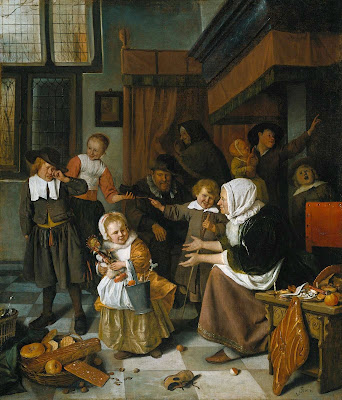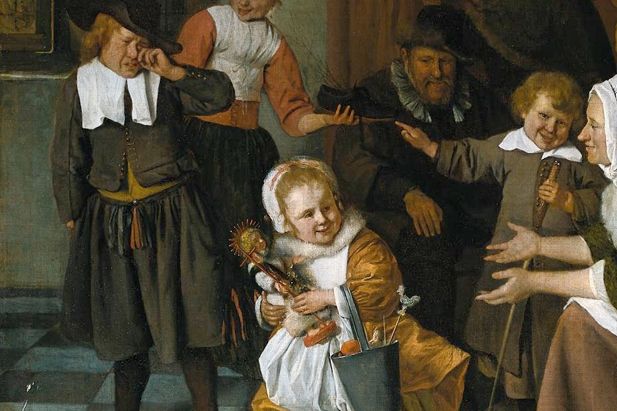



| |
Jan Steen   
Jan Steen was born at the the city of Leiden in 1626, 19 years after his kinsman Rembrandt, and, displaying precocious talent for drawing, was early placed under one Nicolaus Knupfer, a German painter at Utrecht. After this he is supposed to have gone to Haarlem, and to have entered the studio of Adriaan van Ostade.
Steen's last master was Van Goyen, of The Hague, whose daughter, Margaretha, he married there in 1649; he had been enrolled in the Painters' Guild at Leyden in the previous year. From this period till 1672, when many of his best works were painted, he divided his time between Haarlem, Leyden, and The Hague. One of his late biographers, M. Van der Willigen, has found at Haarlem the records of the birth and early burial there of an infant daughter in 1662, and of the burial of his wife there in 1669, and another record to the effect that poor Steen had some of his pictures seized and sold by an apothecary in payment of a debt of "10 florins, 5 sous, and 8 deniers," contracted for medicine during his wife's illness.
The same writer tells us that Steen agreed to give, in payment of one year's rent (1666-1667) of twenty-nine florins, three portraits, "painted as well as he was able," from which we may assume that he did not get very large sums for his work. Three portraits for twenty-nine florins would be at the rate of four dollars apiece; yet, since he paid only twelve dollars a year for rent, we conclude that the purchasing power of money in those days was far gi-eater than it is now. Many an artist of good standing nowadays would be willing to make a like exchange of three portraits for a year's rent.
In 1672 we find Steen back again in Leyden, where, having obtained possession of some property left him by his deceased father, who it is supposed was a
brewer, he applied for and obtained permission to open a tavern at the neighboring village of Langebrug. A year following this he married for the second time, and in 1679 he died, and was buried in the parish church of St. Peter at Leyden.
The picture of the "Feast of St. Nicholas" is one of Jan Steen's best and happiest productions. It measures 33.5 inches high by 27 inches wide, and is said to represent the family of the painter. His father and mother are in the background; his wife, in the foreground, extends her arms to the happpy child.
The festival of St. Nicholas is observed in Holland, not on the 25th of December, but on the 5th, on the eve of which holy day the children hang up their shoes and stockings, and if they have been good and attentive to their studies, Santa Claus graciously fills them with dainties, while he has as certainly a
rod in pickle for the idle and unruly. How much of joy and happiness is expressed in so little space, and how perfect is the arrangement.
The general tone of the coloring, as of all Steen's works, might be characterized as brown, of a golden hue, but neutral; nothing could be more subtle, mellow, or refined. There is a rich note of color in the red back of the chair, while the drapery of the background is of a soft, dull, reddish hue, which is repeated in a higher key in the sleeves of the girl. The wall and casements of the windows are of soft, dull brownish tints, and the dress of the crying boy is of a more decided tone of the same, while that of the old grandmother is of so uncertain a shade of brown as to be equivocal against the reddish curtains. The highest note of this color is in the loaf of bread and the cakes.
The squares of the marble floor are of golden and brownish tones. The velvet sack of the woman extending her arms coaxingly toward the child is of a rich
neutral shade of green, and this tone is delicately repeated in the dress of the old man. The skirt of the woman is gray, of a bluish or purplish cast, and this is repeated in a browner key in the dress of the laughing boy behind her. The dress of the happy child is of a soft shade of ocher, varied with golden and pearly tints. The pail is of a dull leaden hue, and the white draperies are warm and mellow.
The colors are so neutral, tender, and harmonious in their repetitions and minglings, that they quite defy any attempt at description. The delicacy of the values, and the atmosphere of warmth and radiance which suffuses all, wrap the whole in a halo of ideahty. This, combined with that marvelous sensitiveness for values, borrowed from nature, it is true, yet wrought from inner feeling, gives to the work of the Dutch painters that imaginative quality, that " grace and glimmer of romance," without which their realism would be but materialistic, and their probity but the record of dry facts.

| |
|















